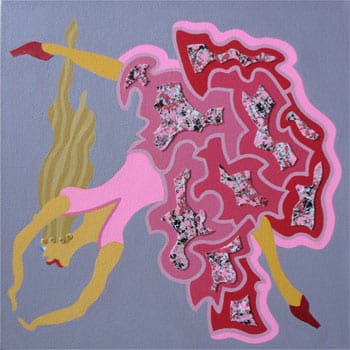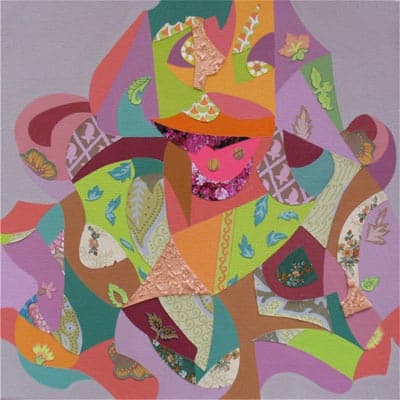by Laura A. Shamas
The physically talented woman-competitor is an amazing feature of many timeless tales.
She runs faster than all the men. She draws the arrow from her quiver, aims and hits her mark perfectly, every time. She swims without fear in the stormy sea. She vaults so high she can nearly touch the sun. She dances with enough force to make thunder. The powerful archetype of the Female Athlete has many names and thrives in cultural traditions worldwide.
We know about real-world female athletes from the history of the Olympics in Greece, first held in honor of the god Zeus. Female athletes are also woven through myth and folklore; they are divine characters and their desires, feats and follies tell us what it means to be human. They represent behavior so “true” that it helps to define who we are today — an old tale, but evergreen.

One historical story from the original Olympics and six representative sacred stories from Greek, Chinese, First Nation and Yoruba traditions explore the significance of the female athlete as a symbol of strength, determination and extraordinary ability.
1. First Olympics. As early as the sixth century B.C. women were running competitively. History tells us that female athletes raced each other in early Olympic games, which were founded to please the gods. The Heraea (or Heraia) was a foot race that predated or coincided with the ancient Olympics. The Heraea was comprised of contests in three different age categories for women, who ran in honor of the goddess Hera. The prize: to become her official priestess. In the stadium at Olympia, women competed wearing tunics, hair down, on a slightly shorter track than the men’s course. Although some writers describe a “No Woman” rule at the ancient Olympics, other literature challenges the accuracy of that interpretation.
But it is historically factual that Cynisca became the first woman athlete in history to win in the ancient Olympics as a charioteer in 396 B.C. and winning again in 392 B.C. Cynisca was immortalized in a bronze statue at the Temple of Zeus. Eurylonis, another female charioteer from ancient Greece, became the second crowned female winner; in Sparta, she, too, was memorialized with a statue.
2. Greek Heroine, Atalanta. Atalanta is the heroine of Greek mythology who could run faster than all of the men. She began life as a royal princess, but because the king only wanted sons, the tiny infant was left in the forest to die. A mothering bear kindly fed Atalanta until she was discovered by a group of hunters. They raised the girl as one of their own. After growing up in the wilderness where she ran freely, Atalanta became a renowned huntress and athlete. Atalanta was a key player in the Hunt for the Calydonian Boar, winning its skin; at funeral games in Pelias’ honor, she won other games — either racing or wrestling, depending on the version of the myth.
By this time, her father, the king, had rediscovered her, and demanded that she, as princess, be wed at once. But Atalanta wanted to remain single, so she announced to the world that she would only marry a man who could beat her in a race. And there was a catch: any suitor who tried to best her and failed would be killed immediately. Even these extreme proclamations and conditions did not deter potential suitors. Many men died trying to win the athletic princess’ hand; Atalanta would give them a head start and they’d still lose. She’d spear them after she caught up with them. It wasn’t until Aphrodite intervened, giving the Golden Apples of Hesperides to Melanion to use in the race as tools of distraction, that Atalanta lost a race, and subsequently married.
| The archetype has made a permanent impression in the human psyche |
3. Lady of the Bow, Artemis. Some accounts say that the gentle female bear who suckled Atalanta was the goddess Artemis in disguise; Atalanta was devoted to the deity. Artemis was known by many epithets, such as “Lady of the Bow” and “Lady of the Wild Beasts.” Like her twin brother Apollo, Artemis was an expert archer, and could use the bow and arrow to kill. Once, Orion angered the goddess; he challenged Artemis to a discus-throwing contest. Artemis killed him, either by hitting Orion with a discus or, in other versions, by sending a poisonous scorpion his way.
There are many Artemisian myths set in the woods, related to hunting: the story of Actaeon is one of the most famous. Artemis magically turned the hunter into a stag for revenge. Why? Because he broke the rules: he spied on the virginal goddess and her acolytes while they were bathing in a spring. To complete her vengeance, she turned Actaeon’s own pack of hunting hounds loose upon him. They devoured the stag.
4. The Amazons. Artemis, obvioulsy a fierce opponent, was also the sacred protectress of the Amazons, the legendary matriarchal collective of independent women in Asia Minor (or Libya) known for their astounding physical prowess, equestrian skills, battle command and intolerance of men. The Amazons were renowned archers and expert riders; by legend, these women were the first people to ride horses. One of their famous Queens was Otrera. In art, circa 470 B.C., they were depicted wearing trousers. The Amazons, as a mythological construction, resonate so strongly with the modern psyche that debates continue about their historical existence.
5. Beloved Goddess of the Sea, Mazu. In Asia, the deity Mazu is a beloved goddess of the sea and a guardian of sailors, part of Buddhist and Taoist traditions. Today, she is one of the most popular deities in China and beyond, with over one hundred million worshippers worldwide.
As an athlete, she was a swimmer. According to tradition, she was born on March 23, 960 with the name Lin Mo Niang (or Lin Moniang). Her father and brothers were fishermen, and Lin Mo Niang would stand guard on the shore, wearing bright red garments, to guide fishermen safely back to port. She performed this duty even during terrible storms. One day, her family did not come back from a fishing trip. Accounts differ as what actually happened next. In one version, Lin Mo Niang went into a trance, and in a shocking vision, saw her father and brothers dangerously awash in a typhoon. Lin Mo Niang could visualize helping them, but her mother interrupted the trance. Eventually, some of her family, but not all, returned home safely. In another story, she died swimming, heroically trying to save her lost father.

6. The Woman Who Leaps. The sacred Paiute story from North America, The Woman and the Giants, features a pole-vaulting female who jumps great distances in order to escape bloodthirsty monsters. Two different giants, Tse’nahaha and Pu’wihi, attack a group of indigenous people. The first one, Tse’nahaha, had a look that could kill, and many people died from his glance. The Woman was able to hide from Tse’nahaha and tried to save a baby. The encounter with the second monster, Pu’wihi, forced the Woman to jump. As she tricked the second monster toward a burning house, the Woman dug her stick into a wild oats patch and vaulted high in the sky, landing near a rock formation where she hid. Pu’wihi eventually found her, but rested a night before attempting to kill her. This next time, the Woman planted her vaulting stick on the rock, so the direction of her jump could not be tracked. The Woman vaulted east to her aunt’s house, perhaps miles, where she was out of danger. The entire Paiute tribe descended from the legendary jumping Woman.
7. Warrior and Dancer, Oya. Oya is an Orisha, a weather-warrior spirit in the Yoruban tradition, originally associated with the River Niger. She has been merged via Santeria with the Catholic figure, “Our Lady of Candelaria.” Oya is so awe-inspiring that when she dances, she creates tornados, thunder and hurricanes. Her flowing skirt creates wind storms, and, as a goddess of the elements, fire is also in her control.
Oya is a bringer of change and transformation, often through destruction first, and she guards the entrance to the underworld and cemeteries. A shapeshifter, she can magically transform herself into a water buffalo. Skilled in combat, she fought alongside her husband, Chango (or Sango), in war. Oya is also a lover of truth, and in Yoruba, her name is translated as “She Tore.” By some, Oya is thought to be a Spirit of the gym today.
The archetype of the Female Athlete has made a permanent impression in the human psyche. Seen in sacred myths and folktales across traditions and time, she is an inspirational figure who mirrors back to us the potency of women. The strong Female Athelete that we meet in these tales is not so different from the women on fields and ball courts today – possessed of amazing achievements, physical prowess, an innate desire to compete and a determination to fight for her people and her causes.
Laura A. Shamas, Ph.D., is a writer and mythologist. Her writing intersects film, non-fiction and theater; her myth essays have been published in the L.A. Times, Newsday, Ecopsychology Journal and other places. Shamas’ “Pop Mythology: Collected Essays” will be released as an e-book in April and in print in May. See www.laurashamas.com.
Also See Girls, Women, Sports: What to Read – by Chané Jones and The Feminist Press in this edition of On The Issues Magazine.
See Curious Tension: Feminism and the Sporting Woman by Susan J. Bandy in this edition of On The Issues Magazine.
Read the Cafe for new and updated stories.
